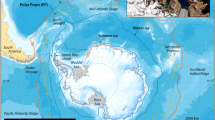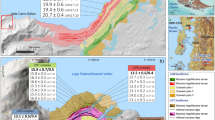Abstract
Millennial-scale cold reversals in the high latitudes of both hemispheres interrupted the last transition from full glacial to interglacial climate conditions. The presence of the Younger Dryas stadial (∼12.9 to ∼11.7 kyr ago) is established throughout much of the Northern Hemisphere, but the global timing, nature and extent of the event are not well established. Evidence in mid to low latitudes of the Southern Hemisphere, in particular, has remained perplexing1,2,3,4,5,6. The debate has in part focused on the behaviour of mountain glaciers in New Zealand, where previous research has found equivocal evidence for the precise timing of increased or reduced ice extent1,2,3. The interhemispheric behaviour of the climate system during the Younger Dryas thus remains an open question, fundamentally limiting our ability to formulate realistic models of global climate dynamics for this time period. Here we show that New Zealand’s glaciers retreated after ∼13 kyr bp, at the onset of the Younger Dryas, and in general over the subsequent ∼1.5-kyr period. Our evidence is based on detailed landform mapping, a high-precision 10Be chronology7 and reconstruction of former ice extents and snow lines from well-preserved cirque moraines. Our late-glacial glacier chronology matches climatic trends in Antarctica, Southern Ocean behaviour and variations in atmospheric CO2. The evidence points to a distinct warming of the southern mid-latitude atmosphere during the Younger Dryas and a close coupling between New Zealand’s cryosphere and southern high-latitude climate. These findings support the hypothesis that extensive winter sea ice and curtailed meridional ocean overturning in the North Atlantic led to a strong interhemispheric thermal gradient8 during late-glacial times, in turn leading to increased upwelling and CO2 release from the Southern Ocean9, thereby triggering Southern Hemisphere warming during the northern Younger Dryas.
This is a preview of subscription content, access via your institution
Access options
Subscribe to this journal
Receive 51 print issues and online access
$199.00 per year
only $3.90 per issue
Buy this article
- Purchase on Springer Link
- Instant access to full article PDF
Prices may be subject to local taxes which are calculated during checkout


Similar content being viewed by others
References
Alloway, B. V. et al. Towards a climate event stratigraphy for New Zealand over the past 30,000 years (NZ-INTIMATE Project). J. Quat. Sci. 22, 9–35 (2007)
Denton, G. H. & Hendy, C. H. Younger Dryas age advance of Franz Josef Glacier in the Southern Alps of New Zealand. Science 264, 1434–1437 (1994)
Barrows, T. T., Lehman, S. J., Fifield, L. K. & DeDeckker, P. Absence of cooling in New Zealand and the adjacent ocean during the Younger Dryas chronozone. Science 318, 86–89 (2007)
Singer, C., Shulmeister, J. & McLea, W. Evidence against a significant Younger Dryas cooling event in New Zealand. Science 281, 812–814 (1998)
Ackert, R. P. et al. Patagonian glacier response during the late glacial–Holocene transition. Science 321, 392–395 (2008)
Moreno, P. I. et al. Renewed glacial activity during the Antarctic cold reversal and persistence of cold conditions until 11.5 ka in SW Patagonia. Geology 37, 375–378 (2009)
Schaefer, J. M. et al. High-frequency Holocene glacier fluctuations in New Zealand differ from the northern signature. Science 324, 622–625 (2009)
Chiang, J. C. H. The Tropics in paleoclimate. Annu. Rev. Earth Planet. Sci. 37, 263–297 (2009)
Anderson, R. F. et al. Wind-driven upwelling in the Southern Ocean and the deglacial rise in atmospheric CO2 . Science 323, 1443–1448 (2009)
Jouzel, J. et al. A new 27 ky high resolution East Antarctic climate record. Geophys. Res. Lett. 28, 3199–3202 (2001)
Rasmussen, S. O. et al. A new Greenland ice core chronology for the last glacial termination. J. Geophys. Res. 111, D06102 (2006)
Brauer, A., Haug, G. H., Dulski, P., Sigman, D. M. & Negendank, J. F. W. An abrupt wind shift in Western Europe at the onset of the Younger Dryas cold period. Nature Geosci. 1, 520–523 (2009)
Severinghaus, J. P., Sowers, T., Brook, E. J., Alley, R. B. & Bender, M. L. Timing of abrupt climate change at the end of the Younger Dryas interval from thermally fractionated gases in polar ice. Nature 391, 141–146 (1998)
Denton, G. H., Alley, R. B., Comer, G. C. & Broecker, W. S. The role of seasonality in abrupt climate change. Quat. Sci. Rev. 24, 1159–1182 (2005)
Yuan, D. et al. Timing, duration, and transitions of the last interglacial Asian monsoon. Science 304, 575–578 (2004)
Lea, D. W., Pak, D. K., Peterson, L. C. & Hughen, K. A. Synchroneity of tropical and high-latitude Atlantic temperatures over the last glacial termination. Science 301, 1361–1364 (2003)
Wang, X.-F. et al. Wet periods in northeastern Brazil over the past 210 kyr linked to distant climate anomalies. Nature 432, 740–743 (2004)
Turney, C. S. M., McGlone, M. S. & Wilmshurst, J. W. Asynchronous climate change between New Zealand and the North Atlantic during the last deglaciation. Geology 31, 223–226 (2003)
Hajdas, I., Lowe, D. J., Newnham, R. M. & Bonani, G. Timing of the late-glacial climate reversal in the Southern Hemisphere using high-resolution radiocarbon chronology for Kaipo bog, New Zealand. Quat. Res. 65, 340–345 (2006)
Vandergoes, M. J., Dieffenbacher-Krall, A. C., Newnham, R. M., Denton, G. H. & Blaauw, M. Cooling and changing seasonality in the Southern Alps, New Zealand during the Antarctic Cold Reversal. Quat. Sci. Rev. 27, 589–601 (2008)
Putnam, A. et al. In situ cosmogenic 10Be production-rate calibration from the Southern Alps, New Zealand. Quat. Geochronol. 5, 392–409 (2010)
Chinn, T. J., Winkler, S., Salinger, M. J. & Haakensen, N. Recent glacier advances in Norway and New Zealand; a comparison of their glaciological and meteorological causes. Geogr. Ann. 87A, 141–157 (2005)
Anderson, B. & Mackintosh, A. Temperature change is the major driver of late-glacial and Holocene fluctuations in New Zealand. Geology 34, 121–124 (2006)
Carter, L., Manighetti, B., Ganssen, G. & Northcote, L. Southwest Pacific modulation of abrupt climate change during the Antarctic Cold Reversal-Younger Dryas. Palaeogeogr. Palaeoclimatol. Palaeoecol. 260, 284–298 (2008)
Blunier, T. J. et al. Timing of the Antarctic cold reversal and the atmospheric CO2 increase with respect to the Younger Dryas event. Geophys. Res. Lett. 24, 2683–2686 (1997)
Broecker, W. S. in Ocean Circulation: Mechanisms and Impacts (ed. Schmittner, A., Chiang, J. C. H. & Hemming, S. R.) 265–278 (Geophys. Monogr. Ser. 173, American Geophysical Union, 2007)
Timmermann, A. et al. The influence of a weakening of the Atlantic meridional overturning circulation on ENSO. J. Clim. 20, 4899–4919 (2007)
Birkeland, P. W. Subdivision of Holocene glacial deposits, Ben Ohau Range, New Zealand, using relative-dating methods. Geol. Soc. Am. Bull. 93, 433–449 (1982)
EPICA. community members. Eight glacial cycles from an Antarctic ice core. Nature 429, 623–628 (2004)
Lemieux-Dudon, B. et al. Consistent dating for Antarctic and Greenland ice cores. Quat. Sci. Rev. 29, 8–20 (2010)
Acknowledgements
We thank the Comer family and W. Broecker for their support of our work. We thank B. Goehring for assisting with probability plots, S. Kelley for field assistance, T. Ritchie and K. Ritchie at Lake Ruataniwha Holiday Park for hospitality and the Helicopter Line at Glentanner Park. This research is supported by the Gary C. Comer Science and Education Foundation, the National Oceanographic and Atmospheric Administration (specifically support to G.H.D. and for field work), and National Science Foundation awards EAR-0745781, 0936077 and 0823521. D.J.A.B. was supported by Foundation for Research, Science and Technology contract CO5X0701. This is LDEO contribution #7371.
Author information
Authors and Affiliations
Contributions
G.H.D., M.R.K. and J.M.S. instigated this research. M.R.K., J.M.S., R.C.F. and R.S. were responsible for all laboratory efforts, including sample processing, and data interpretation. M.R.K., A.E.P. and A.M.D. participated in field work and designed the field sampling strategies. D.J.A.B., T.J.H.C. and B.G.A. were mainly responsible for the mapping, glacier reconstructions and ELA estimates. All authors contributed to manuscript preparation.
Corresponding author
Ethics declarations
Competing interests
The authors declare no competing financial interests.
Supplementary information
Supplementary Information
This file contains Supplementary Methods, a Supplementary Discussion, Supplementary Tables 1-3, additional references, Supplementary Figures 1- 4 with legends and Supplementary Statistics relating to Supplementary Figure 1 and Figure 1 in the main paper. (PDF 1802 kb)
PowerPoint slides
Rights and permissions
About this article
Cite this article
Kaplan, M., Schaefer, J., Denton, G. et al. Glacier retreat in New Zealand during the Younger Dryas stadial. Nature 467, 194–197 (2010). https://doi.org/10.1038/nature09313
Received:
Accepted:
Issue Date:
DOI: https://doi.org/10.1038/nature09313
This article is cited by
-
Moraines in the Austrian Alps record repeated phases of glacier stabilization through the Late Glacial and the Early Holocene
Scientific Reports (2022)
-
Glacier fluctuations in the northern Patagonian Andes (44°S) imply wind-modulated interhemispheric in-phase climate shifts during Termination 1
Scientific Reports (2022)
-
10Be age constraints on latest Pleistocene and Holocene cirque glaciation across the western United States
npj Climate and Atmospheric Science (2019)
-
Ocean thermometer from the past
Nature (2018)
-
Monitoring elevation change of glaciers on Geladandong Mountain using TanDEM-X SAR interferometry
Journal of Mountain Science (2017)
Comments
By submitting a comment you agree to abide by our Terms and Community Guidelines. If you find something abusive or that does not comply with our terms or guidelines please flag it as inappropriate.



